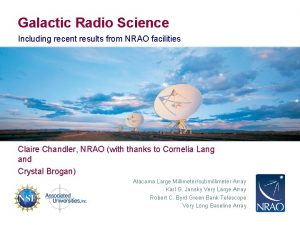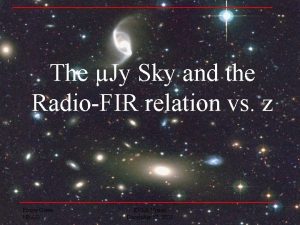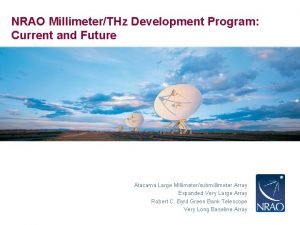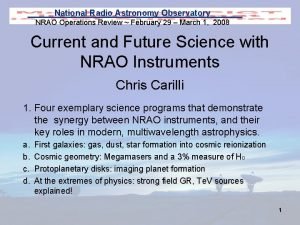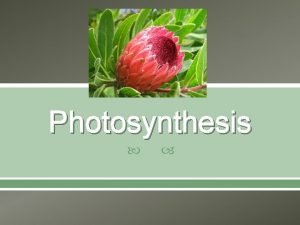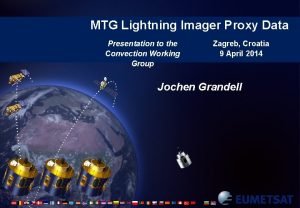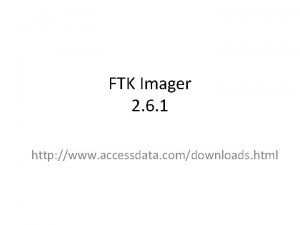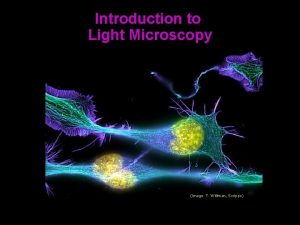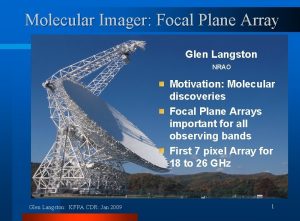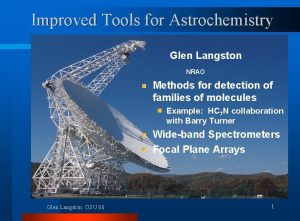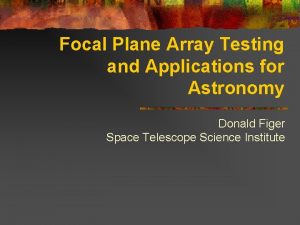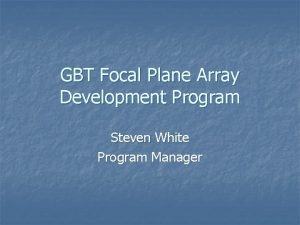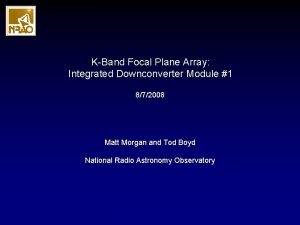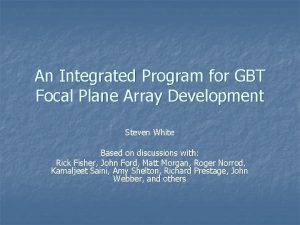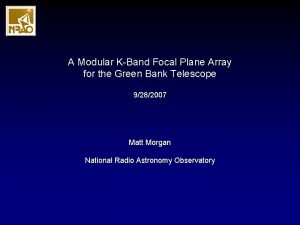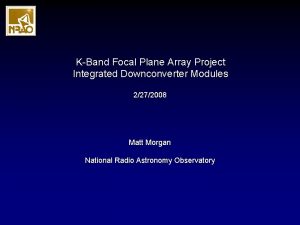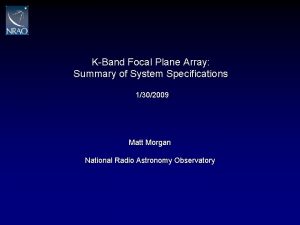Molecular Imager Focal Plane Array Glen Langston NRAO
















- Slides: 16

Molecular Imager: Focal Plane Array Glen Langston NRAO Motivation: Molecular discoveries Focal Plane Arrays important for all observing bands First 7 pixel Array for 18 to 26 GHz Glen Langston: KFPA CDR: Jan 2009 1

Molecular Discoveries: 100 m World’s most sensitive Telescope in frequency range 10 to 50 GHz Discovered >7 new large interstellar molecules, including propenal and propanal Widely distributed, not exclusively in compact cores Hollis, Snyder, Remijan and Jewell 2004 -2008 Glen Langston: KFPA CDR: Jan 2009 Langston, Turner 2007 2

Molecular Line Surveys Science goals require wide instantaneous bandwidths Prime targets have many widely spaced narrow lines. Widely separated (Delta nu > 1 GHz) Glen Langston: KFPA CDR: Jan 2009 3

st 1 Pixel Tests Completed September 11, 2008 – Single Pixel Tests on GBT October 6, 2008 – IDM 1 IF Spur studies – Measure versus feed position October 12, 2008 – Comparison of Current GBT Kband (K 0) and Single Pixel (K 1) December 28, 2008 – IDM 2 – Check of System temperature and compare K 0 with K 1 https: //safe. nrao. edu/wiki/bin/view/Kbandfpa/Single. Pixel. Testing Glen Langston: KFPA CDR: Jan 2009 4

First Astronomical Tests Peak and Focus results good. Obs revealed IF spurs, that are now understood. Extensive tests of interfaces. Web based monitor http: //172. 23. 1. 79/ CLEO /Astrid scripts worked for test obs. Obs on Sept 11, 2008 Glen Langston: KFPA CDR: Jan 2009 5

st 1 Pixel Tests: Frequency Range Orion A 18 -26. 5 GHz H and He Recombination Lines Water Line and molecules Negative features are IF spurs Initial tests showed IF spur problems (now fixed) Glen Langston: KFPA CDR: Jan 2009 6

Gain and Tsys Tests Performed intensity measurements as a function of pixel offset from center location. Gain versus Position Offset 3. 8’ in Azimuth and Elevation directions (LCP and RCP) Frequency Offset-Azimuth (GHz) Average 19 97. 7 +/- 2. 5 % 25 99. 4 +/- 4. 4 % Offset-Elevation Average 95. 2 +/- 2. 5 % 89. 4 +/- 4. 5 % Performed a sequence of obs with K 0 Feed system followed by K 1 sequence. Found higher system temperatures Cause: Low gain and IF spurs Obs Oct 6, 2008 https: //safe. nrao. edu/wiki/bin/view/Kbandfpa/TKfpa 08 Oct 06 Glen Langston: KFPA CDR: Jan 2009 7

Spectral Line Tests Configured for TMC NH 3 1 -1 and 2 -2 Lines, plus HC 7 N Baseline Performance Good, similar to K 0 Glen Langston: KFPA CDR: Jan 2009 8

Baseline Stability Check Comparison of twenty five 90 second observations Obs. Sig-Ref/Ref calibrated with same average reference scan No significant baseline structure changes. No baseline fit subtracted, only single average value plus an offset to separate spectra Glen Langston: KFPA CDR: Jan 2009 9

st 1 Pixel Tests: Line Mapping Taurus Molecular Cloud HC 7 N NH 3 Simultaneous Maps of several lines Note High GBT Sensitivity: Only 2 seconds per pixel! Glen Langston: KFPA CDR: Jan 2009 10

RMS noise Versus Time RMS decreases roughly as expected with time. Plot shows measured RMS in spectra and sqrt(T) model. Common Reference may add to systematic noise. Glitch may be due to weather or Processing (? ) Glen Langston: KFPA CDR: Jan 2009 11

K 0/K 1 Tsys Comparison K 0/K 1 Comparisons at 19, 21, 23 and 25 GHz show comparable performance Weather Variations limit comparison accuracy All obs show increasing Tsys with time. 23 GHz results typical Obs on Dec. 28, 08 Glen Langston: KFPA CDR: Jan 2009 12

Efficiency Estimate at 23 GHz Efficiency estimated by comparison of 3 C 123 peak intensities (K) for K 0 and K 1. Two K 0 measurements and one K 1 Measurements at 23 GHz. Weather dominates uncertainty (and cal values) https: //safe. nrao. edu/wiki/bin/view/Kbandfpa/Kband. Te sts 08 Dec 28 Glen Langston: KFPA CDR: Jan 2009 K 1/K 0 Efficiency LCP RCP ==== 99% 84% 95% 79% 96% 81% 88% 75% Ratio of 3 C 123 Peak Heights 13

Mapping Tests: Multiple Beams HC 5 N HC 7 N Software for Mapping Tests using Current GBT Rx: Two Beam mapping works, must write software for 7 beams. Glen Langston: KFPA CDR: Jan 2009 14

IDM 2 Tests 2 nd IDM showed no IF spurs Tsys performance similar to K 0 Glen Langston: KFPA CDR: Jan 2009 15

Summary: Planned Tests Accomplished First On Telescope tests showed good basic performance, and identified engineering tasks Tests of gain offsets versus feed position were consistent with predictions. Second IDM seems free of IF Spurs Baseline stability seems good Comparison of K 0/K 1 is good (Weather limits accuracy) RMS decreasing with integration time. Further observations needed for firm conclusions Wide frequency (18 to 26 GHz) observations are critical for study of important large molecules and Chemistry. Glen Langston: KFPA CDR: Jan 2009 16
 Software-defined networking: a comprehensive survey
Software-defined networking: a comprehensive survey Nrao
Nrao Nrao
Nrao Mynrao
Mynrao Nrao
Nrao Nrao
Nrao Huq dry imager factory
Huq dry imager factory Lightning imager
Lightning imager Mirjana pavlovic
Mirjana pavlovic Oxygen forensic
Oxygen forensic Accessdata ftk imager
Accessdata ftk imager Conjugate focal plane
Conjugate focal plane Covalent bond
Covalent bond Giant molecular structure vs simple molecular structure
Giant molecular structure vs simple molecular structure Giant molecular structure vs simple molecular structure
Giant molecular structure vs simple molecular structure Photovoltaic array maximum power point tracking array
Photovoltaic array maximum power point tracking array Array tiga dimensi
Array tiga dimensi

